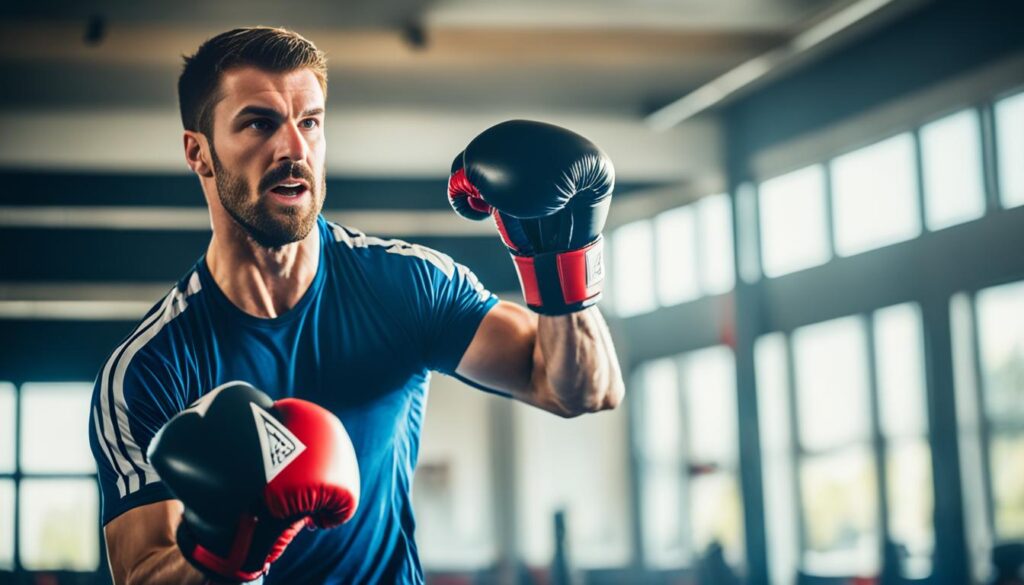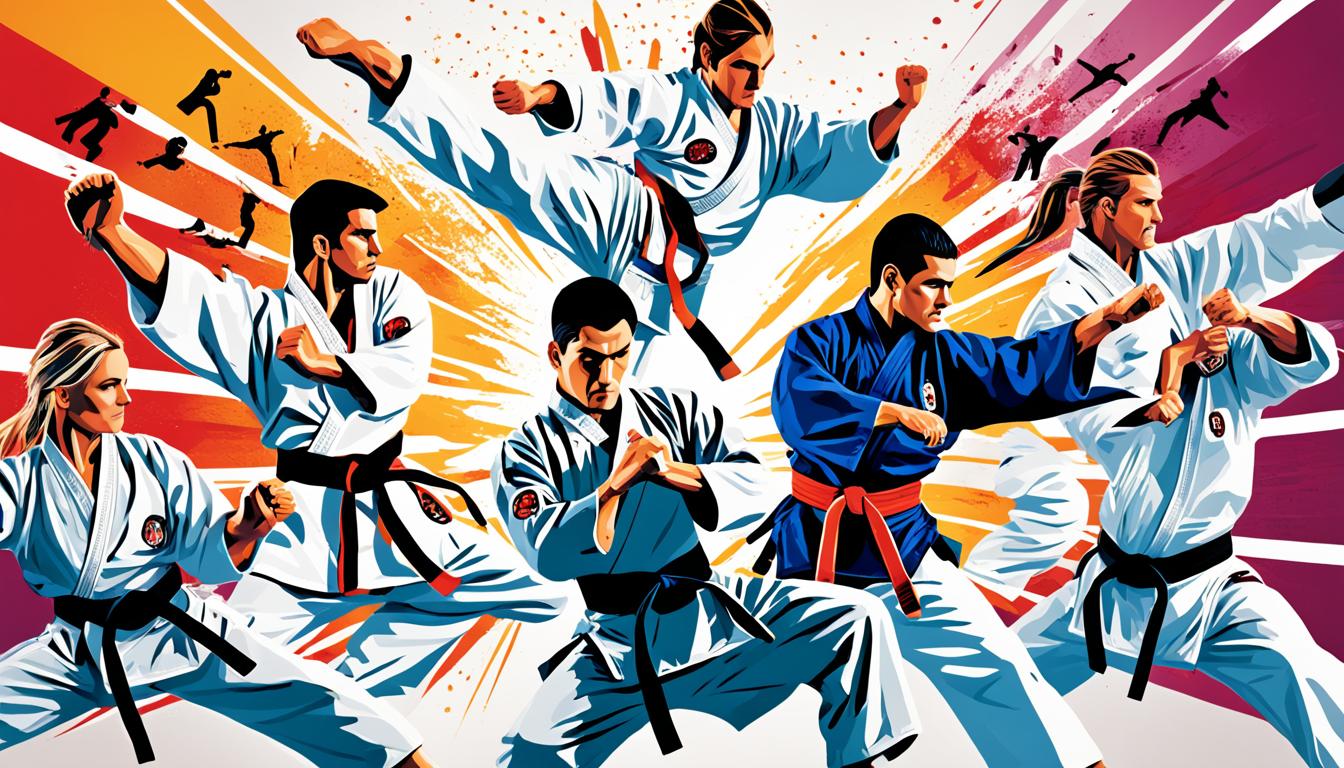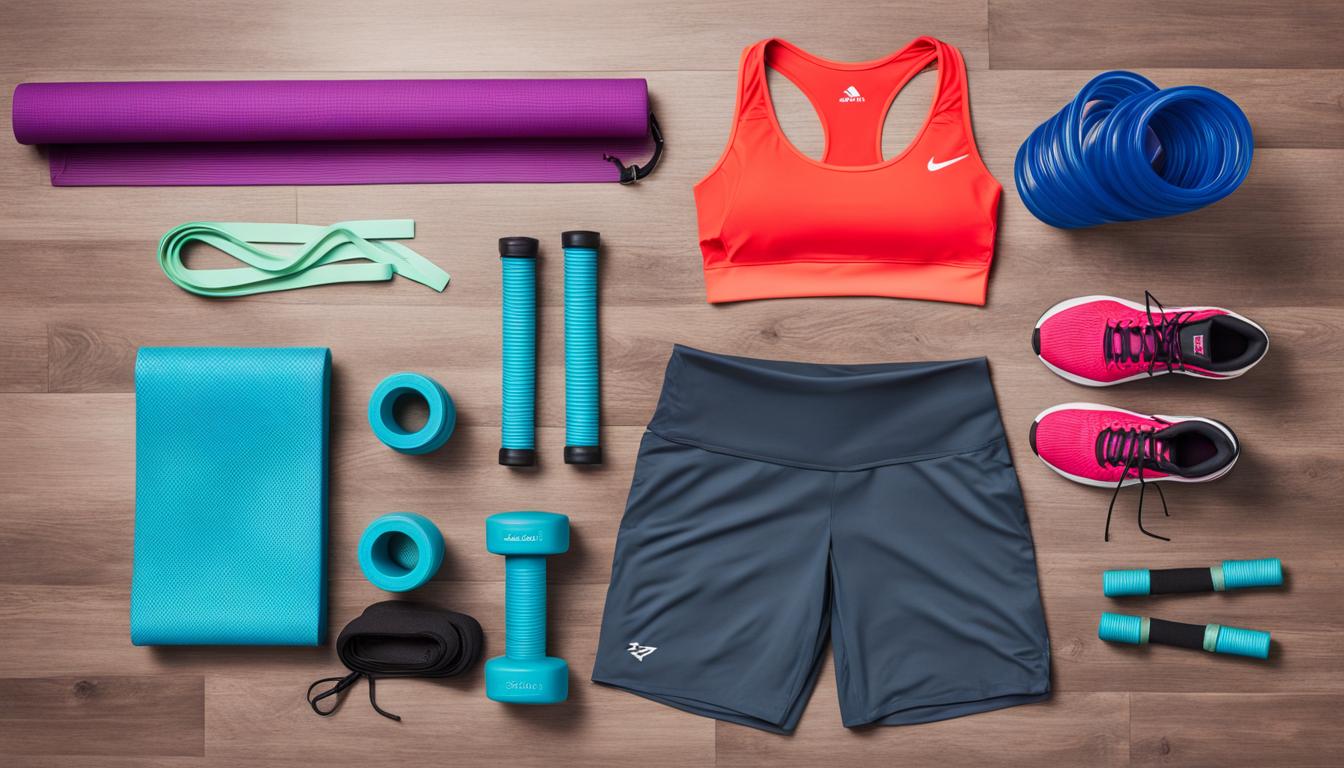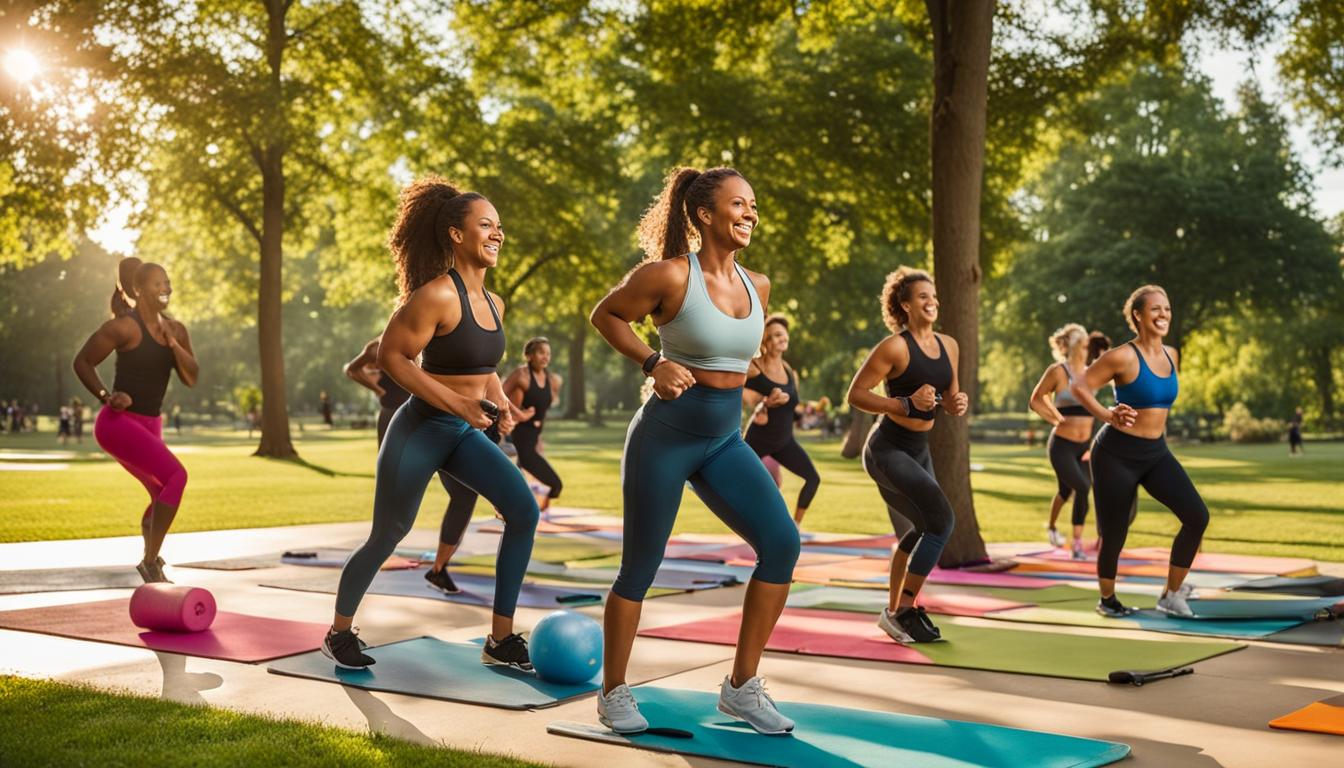The world of martial arts is wide and varied. It offers many disciplines that fit different interests and goals. From hitting techniques to defending yourself, each martial art has its own benefits and unique traits. Whether you want to learn old combat arts or try new training ways, there’s a martial art for you.
In this article, we’ll look into various martial arts, exploring types, popular styles, and their main ideas. This guide will help you, whether you’re just starting or have a lot of experience. It aims to make you more familiar with martial arts. And it will guide you in finding the one that matches your vibes.
Key Takeaways:
- There are many different types of martial arts, each with its own unique characteristics and purpose.
- Martial arts disciplines include Muay Thai, Taekwondo, Tai Chi, Kickboxing, Karate, Kung Fu, Aikido, Judo, Kendo, Krav Maga, Wing Chun, Jeet Kune Do, Hapkido, Capoeira, Brazilian Jiu-Jitsu, and Jiu-Jitsu.
- Martial arts training programs aim to enhance strength, skill, and self-defense abilities.
- Each martial art focuses on different techniques, such as strikes, kicks, joint locks, throws, and ground-based grappling.
- Discovering the right martial art for you is a personal journey that aligns with your interests, goals, and values.
Muay Thai: The Art of Eight Limbs
Muay Thai, or Thai Boxing, is powerful and comes from Thailand. It is known for striking and clinch techniques. These make it an effective way to defend oneself.
The history of Muay Thai goes back to ancient Siamese warriors. It was created for close combat and self-defense. Now, people around the world practice and respect it for its effectiveness in fights and real situations.
Muay Thai is different because it uses eight limbs: punches, elbows, knees, and shins. Fighters learn to use every part of their body. This makes it a versatile and deadly combat form.
Muay Thai mixes strikes like punches and kicks with clinch techniques. These involve grappling and controlling the opponent’s body at close range. This complete strategy lets fighters handle different scenarios well.
To get good at Muay Thai, hard training is a must. Practice on pads with a partner, and heavy bag training, build power and fitness. Sparring tests skills in close-to-real fight settings. Running, skipping rope, and strength exercises also improve fitness, power, and stamina.
This picture shows two Muay Thai fighters using striking techniques and movements:
| Techniques | Description |
|---|---|
| Striking Techniques | Punches, kicks, elbows, and knees |
| Clench Techniques | Grappling, controlling, and striking in close-quarters |
| Self-Defense | Effective techniques to protect oneself in real-life situations |
| Training Methods | Pad work, heavy bag training, sparring, conditioning drills |
Muay Thai is more than a martial art. It shapes your discipline, mental toughness, and physical fitness. Whether for defense, competition, or health and confidence, Muay Thai offers full body and mind growth. Dive into this art and unlock your inner strength.
Taekwondo: The Way of the Foot and Fist
Taekwondo comes from Korea, focusing on kicks, punches, and self-protection. It is grounded in Korean fighting traditions. This martial art teaches discipline, personal growth, and defensive skills. Practitioners improve in flexibility, balance, speed, and strength. They also learn about respect and discipline.
The training covers different areas, including high kicks, precise punches, forms, sparring, and breaking boards. Taekwondo teaches how to strike, kick, and defend effectively. This helps people protect themselves and others.
Taekwondo stresses mental strength. Training boosts discipline, commitment, and inner power. This helps practitioners face challenges in martial arts and life. They learn to be mentally tough, focused, and determined.
For both experienced fighters and novices, Taekwondo offers growth in both body and mind. Practitioners get better at defending themselves. They also gain confidence and discipline to tackle life’s obstacles.
The Benefits of Taekwondo Training
- Enhances physical fitness and coordination
- Develops flexibility and balance through high kicks
- Improves speed and agility for quick and precise movements
- Sculpts and strengthens the body’s muscles
- Cultivates discipline, respect, and mental strength
- Fosters self-confidence and self-esteem
- Offers a practical self-defense system
By practicing Taekwondo, people start a journey of self-discovery and growth. They gain self-defense skills, mental resilience, and the discipline needed to face life confidently.
Notable Taekwondo Practitioners
| Name | Achievements |
|---|---|
| Hwang Kee | Founder of the martial art Tang Soo Do, a precursor to modern Taekwondo |
| Hadi Saei | Iranian Taekwondo athlete, two-time Olympic gold medalist |
| Choi Hong Hi | Founder of Taekwondo and creator of the patterns (forms) used in training |
| Jade Jones | British Taekwondo athlete, Olympic gold medalist |
These renowned figures have excelled in Taekwondo and inspire many who wish to master this martial art.
Tai Chi: The Art of Harmony and Balance
Tai Chi is an ancient Chinese martial art known for its calm movements. It aims for relaxation, balance, and inner peace. It was created by a Taoist monk to help cultivate internal energy and balance in body and mind. People practicing Tai Chi go on a journey of self-discovery and wellness.
The training in Tai Chi involves slow, controlled movement sequences. These movements help with mindfulness and ensure smooth transitions. By focusing on the moment and keeping breath calm, practitioners improve their concentration and connection between mind and body.
Practicing Tai Chi with a partner is key. Partner exercises help practitioners react to others’ movements with awareness and adaptability. It boosts physical skills and mental agility.
“Tai Chi is the ultimate expression of softness overcoming hardness, of yielding overcoming force. It is a gentle art that carries immense power within.”
Tai Chi is gentle, making it perfect for all ages and fitness levels. It is known for its health benefits, but it also includes self-defense techniques. This makes Tai Chi a versatile martial art useful in many ways.
Benefits of Tai Chi:
- Promotes relaxation and stress reduction
- Improves balance, flexibility, and posture
- Enhances focus and mental clarity
- Boosts overall physical well-being and vitality
- Increases self-awareness and mind-body connection
Tai Chi’s slow movements are good for the body, mind, and spirit. Practicing Tai Chi leads to inner peace and harmony. It helps people handle life with grace and calmness.
Experience the beauty of Tai Chi:
| Training Methods | Description |
|---|---|
| Sequences | Performing slow and controlled movements in a continuous flow |
| Partner Work | Engaging in exercises to develop sensitivity and responsiveness |
| Form Practice | Learning and refining structured routines |
| Meditation | Cultivating a calm and focused mind through mindfulness techniques |
Kickboxing: The Fusion of Strikes and Kicks
Kickboxing is a mix of martial arts that blends striking and kicking. It started in the 1960s and now is loved worldwide. Both men and women join to push their limits in competition.
Training sharpens striking skills, builds physical strength, and teaches self-defense. Fighters learn punches, kicks, and knee strikes. It’s not just about attack; it’s also about quick thinking and strategy.
To get good at kickboxing, fighters practice in many ways. They use pads to work on their accuracy and timing. Hitting a heavy bag builds their power. Sparring lets them try out what they’ve learned in real settings. Drills boost their speed and stamina, making them complete fighters.
“Kickboxing is not just about delivering powerful strikes; it’s about the perfect harmony between agility, accuracy, and timing.” – Aliya Khan, Kickboxing Champion
Being successful in kickboxing takes hard work, discipline, and the will to keep going. Fighters must be quick to switch between attacks to beat their rivals. Being agile is key, helping them dodge and counterattack effectively.
Gaining Agility in Kickboxing Training
Improving agility is key in kickboxing. Fighters work on their footwork and quick reactions to be more agile in the ring. Here’s how they do it:
- Jumping rope: This improves footwork and speed, helping fighters move quickly and stay balanced.
- Ladder drills: These drills boost foot speed and agility, making it easier to avoid opponents.
- Shadowboxing: This practice improves movements and speed without needing a partner.
With hard work and persistence, kickboxers get the agility they need to win.

Kickboxing is an exciting and skillful sport that combines various fighting techniques. Through training, fighters become faster, more powerful, and accurate. Their training in agility lets them handle any challenge and win fights.
Karate: The Art of Powerful Strikes
Karate is a traditional Japanese fighting style. It stresses strong strikes, kicks, knee strikes, and open-hand techniques. It started in Okinawa during the Ryukyu Kingdom era as self-defense against threats. Karate improves skills like posture, balance, coordination, speed, power, and focus.
Karate students undergo tough training to master the martial art. They learn basic techniques to hit and kick with force and accuracy. Practicing forms, or katas, boosts physical and mental health. This ensures smooth movements and strong mental discipline.
Sparring lets students test their skills in a safe setting, sharpening their defenses and reaction times. Self-defense moves, or bunkai, teach them to protect themselves in real situations.
Karate is more than just physical. It builds on traditional values and philosophy. Students learn discipline, respect, and perseverance, aiming for self-improvement. This training builds inner strength and resilience, helping people in all aspects of life.
Mastering Karate is a lifelong path. It’s not just about techniques, but growing in character and mental strength. By following Karate’s teachings, people gain from its defense moves, values, and training approaches. This leads to personal growth and confidence.
Key Elements of Karate
| Element | Description |
|---|---|
| Strikes | Powerful punches, kicks, and knee strikes |
| Forms (Katas) | Sequences of movements for physical and mental conditioning |
| Sparring | Controlled combat to enhance self-defense skills and reaction time |
| Self-Defense Techniques (Bunkai) | Practical application of techniques in real-life scenarios |
| Traditional Values | Discipline, respect, perseverance, and self-improvement |
| Training Methods | Emphasizes physical conditioning, mental focus, and skill development |
Kung Fu: The Art of Chinese Martial Arts
Kung Fu comes from Chinese martial arts and offers various styles. These include Shaolin Kung Fu, Wing Chun, Tai Chi, Baguazhang, and Xingyiquan. It focuses on blending hard and soft fighting techniques. Originating in Chinese Buddhist monasteries, Kung Fu highlights discipline and the quest for balance.
Kung Fu training mixes different techniques, partner work, and physical conditioning. Students learn graceful moves, punches, kicks, and how to use weapons. This training boosts both body and mind, focusing on resilience and focus.
Kung Fu is known for its acrobatic flair. These moves show the practitioners’ flexibility and strength, making it exciting to watch.
“Kung Fu goes beyond fighting. It’s a lifestyle that enhances personal growth and self-understanding. Through training, one gains strength, character, and physical skill.”
Diving into Kung Fu training leads to self-improvement. The discipline needed goes beyond the martial art, influencing every part of life.
Benefits of Kung Fu Training:
- Enhanced physical fitness, strength, and endurance
- Improved flexibility, agility, and coordination
- Increased mental focus, discipline, and self-awareness
- Effective self-defense skills
- Promotion of balance and harmony in body, mind, and spirit
Comparison of Kung Fu Styles
| Style | Fighting Techniques | Origins | Training Emphasis |
|---|---|---|---|
| Shaolin Kung Fu | Hand strikes, kicks, acrobatics | Shaolin Monastery in China | Physical conditioning, combat techniques |
| Wing Chun | Close-range strikes, grappling, trapping | Southern China | Efficiency of technique, sensitivity training |
| Tai Chi | Slow, flowing movements | China | Breathing, relaxation, energy cultivation |
| Baguazhang | Circular footwork, palm strikes | China | Movement principles, agility, meditation |
| Xingyiquan | Linear strikes, explosive power | China | Internal energy cultivation, practical applications |
Conclusion
Martial arts training is more than just self-defense. It’s a path to self-improvement and growth. This article covered different martial arts like Muay Thai, Taekwondo, Tai Chi, Kickboxing, Karate, and Kung Fu. Each has unique skills and ideas.
Training in martial arts makes you stronger and teaches self-defense. It also builds discipline and respect. Martial arts improve your life skills, like perseverance, focus, and mental strength.
You might like Karate’s strong strikes, Tai Chi’s smooth moves, or Kickboxing’s fast punches and kicks. Each martial art helps you find your inner strength. Take on the challenge, train hard, and explore yourself through martial arts.
FAQ
What are the different types of martial arts?
There’s a wide array of martial arts. These include Muay Thai, Taekwondo, Tai Chi, and Kickboxing. You’ll also find Karate, Kung Fu, Aikido, and Judo. Plus, there’s Kendo, Krav Maga, Wing Chun, and Jeet Kun Do. Added to that are Hapkido, Capoeira, Brazilian Jiu-Jitsu, and Jiu-Jitsu.
What techniques are used in martial arts?
In martial arts, various techniques are used. You come across strikes, kicks, and joint locks. Also part of the array are throws and ground-based grappling.
What is the purpose of martial arts training programs?
The aim of martial arts training is to boost your strength, skill, and self-defense.
What is Muay Thai?
Muay Thai is a vibrant fighting style from Thailand. It skillfully mixes punches, elbows, knees, and shins. The clinch techniques are major too.
What are the training methods in Muay Thai?
Muay Thai’s training includes pad work and heavy bag training. Sparring and conditioning drills help improve strength, speed, and mental toughness.
What is Taekwondo?
Taekwondo is a Korean martial art focusing on quick and high kicks. It also zooms in on precise hand techniques and mental strength.
How is Taekwondo trained?
Training in Taekwondo covers self-defense, forms, sparring, and breaking boards. It’s quite diverse.
What is Tai Chi?
Tai Chi is a time-honored Chinese martial art. It involves slow, graceful movements for promoting calm, balance, and inner peace.
How is Tai Chi practiced?
Practicing Tai Chi means moving slowly and with control. It emphasizes being mindful of your body, calm breathing, and staying focused.
What is Kickboxing?
Kickboxing blends martial arts, using punches and kicks. It highlights fast moves and agility.
What are the training methods in Kickboxing?
Training in Kickboxing sharpens striking skills and physical condition. Pad work, heavy bag drills, sparring, and conditioning are key.
What is Karate?
Karate is a traditional Japanese style. It centers on strong strikes, kicks, and open-hand techniques.
How is Karate trained?
Training in Karate focuses on improving your posture, balance, and speed. There’s also a big focus on power and concentration through techniques and forms.
What is Kung Fu?
Kung Fu represents various Chinese martial arts. They include both hard and soft techniques.
How is Kung Fu trained?
Kung Fu training uses techniques, forms, and drills. It’s designed to develop your stance, footwork, hand strikes, and weapon skills.
What are the benefits of martial arts training?
Training in martial arts boosts strength and skills. It also fosters discipline, respect, and self-growth.
How can martial arts help with personal growth and development?
Martial arts training is a valuable experience. It helps you tackle challenges, stay committed, and find the martial art that suits you.





